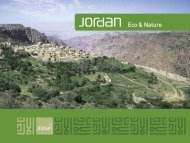You also want an ePaper? Increase the reach of your titles
YUMPU automatically turns print PDFs into web optimized ePapers that Google loves.
BETHANY BEYOND THE JORDAN<br />
The site of John the Baptist’s settlement at Bethany Beyond the<br />
Jordan, where Jesus was baptised, has long been known from<br />
the Bible and from Byzantine and medieval texts.<br />
The actual site has now been identified as the site that extends<br />
between Tell al-Kharrar (Elijah’s Hill / Tall Mar Elias in Arabic)<br />
and John the Baptist Church area, on the east bank of the Jordan<br />
River in the Hashemite Kingdom of Jordan. Tell al-Kharrar is<br />
the same place from which Elijah is believed to have ascended<br />
to heaven in a whirlwind on a chariot of fire. Wadi al-Kharrar<br />
is believed to be Kerith Ravine, the natural stream “east of the<br />
Jordan” where God commanded Elijah to seek refuge from<br />
King Ahab and Queen Jezebel.<br />
At the time it was appropriate for John the Baptist to begin<br />
his mission from the same place that Elijah had ended his<br />
life, as both of these leading Biblical prophets played similar<br />
theological roles: they both confronted the religious laxity<br />
of their times, challenged political authority, announced the<br />
imminent arrival of the Messiah, and urged the populace to<br />
repent and lead righteous lives.<br />
immediately after he was baptized by John and anointed by<br />
God. Several events took place during this three-day stay<br />
at Bethany: It was here that Jesus first prayed to God and it<br />
was here that he gathered his first disciples – Simon, Peter,<br />
Andrew, Philip, and Nathaneal. Pottery, coins, stone objects,<br />
and architectural remains confirm the site was used in the<br />
early 1 st century AD, during the time of Jesus and John. The<br />
extensive architectural remains, which can be seen on “Elijah’s<br />
Hill” are from the 5 th – 6 th century Byzantine monastery and<br />
contain churches and chapels, baptism and water storage<br />
pools, and water systems. The 3 rd century Roman building<br />
with fine mosaics is believed to be an early Christian ‘Prayer<br />
Hall’ – probably the earliest building, for this specific use, to<br />
have been identified anywhere in the world.<br />
Also identified is the cave where John the Baptist lived and<br />
carried out his works. Early pilgrims noted that water flowed<br />
from the cave, which John drank and used for baptisms. The<br />
cave was transformed into a church during the Byzantine<br />
period (early 4 th to early 7 th centuries AD). The water channel<br />
and the church, which is built around the cave, have been<br />
recently excavated.<br />
4<br />
For almost two millennia, this area which extends along the<br />
east bank of the Jordan River, opposite Jericho, has been known<br />
to be the place where Jesus Christ was baptized by John. But, in<br />
1996, stunning archaeological discoveries identified the exact<br />
site where John had been living and carrying out his baptisms,<br />
as Bethany Beyond the Jordan. The Bible (John 10:40) refers<br />
to this place when, after being threatened with stoning in<br />
Jerusalem “Jesus went back across the Jordan to the place where<br />
John had been baptizing in the early days”.<br />
Though Jesus Christ’s divinely inspired role was announced<br />
before and during his birth, he actually launched his public<br />
ministry at Bethany Beyond the Jordan at the age of 30,<br />
John the Baptist Church area from the East.<br />
<br />
The Jordan River.



